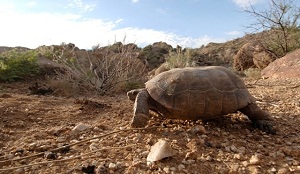Study: Little known of large solar projects’ impact on wildlife
 Not many can agree about how utility-scale solar projects, like those in the U.S. desert Southwest, will impact wildlife, but it could be harmful despite efforts to mitigate those impacts. That’s according a new report in the December issue of BioScience.
Not many can agree about how utility-scale solar projects, like those in the U.S. desert Southwest, will impact wildlife, but it could be harmful despite efforts to mitigate those impacts. That’s according a new report in the December issue of BioScience.
The potential effects of the construction and decommissioning of solar projects include killing wildlife. Longer term effects include the environmental impacts of dust and dust suppressants and habitat modification, according to “Wildlife Conservation and Solar Energy Development in the Desert Southwest, United States.”
The report stated: “Currently available peer-reviewed data are insufficient to allow a rigorous assessment of the impact of [utility-scale solar energy development] on wildlife.”
The report, by Jeffrey Lovich and Joshua Ennen of the US Geological Survey's Southwest Biological Science Center, looks into the impact such projects could have on species like the Agassiz's desert tortoise.
Lovich, deputy director of the center, has evaluated the impacts of other renewables, like wind, on terrestrial and avian wildlife.
“I’m very familiar with wind projects,” he said. “I was struck by the fact that there was hardly any literature [on the impacts of solar].”
In fact, their investigation revealed that there was only one such peer-reviewed study.
“We were only able to find one published paper and that was from 1986,” he said.
That research, by D.C. Pearson, was conducted before the Agassiz’s desert tortoise was considered a threatened species, as it is now, and before most people were considering as many large-scale solar projects.
What’s at stake is a loss of biodiversity in the regions. The desert tortoise is an important species to the region because it’s forged a symbiotic relationship with other wildlife, according to Lovich. Other animals will use abandoned burrows dug by the tortoise.
It’s not clear what impact developing large-scale projects will have, nor what impact translocating will have on the desert tortoise, which have adapted to the environment over the course of 3 million years, Lovich said. Since they take 18 years to reach maturity, long-term studies into how the projects will impact the tortoises need to be done.
“Translocation has a very checkered history of success,” Lovich said.
He cited a recent army base translocation of the tortoises that killed roughly half of the moved animals. Still, there are signs that the method is improving.
“Some have shown that it hasn’t worked,” he said. “Success is improving, but it’s still not where we’d like it to be.”
Smart siting of future projects that don’t have a great impact on desert wildlife is also recommended.
“I think everybody would like to see renewable energy [grow] without harming wildlife,” Lovich said.
Developers and other players just need to make sure that things are done properly to reduce the impact as much as possible.
Image courtesy of Arizona Game and Fish Department.



